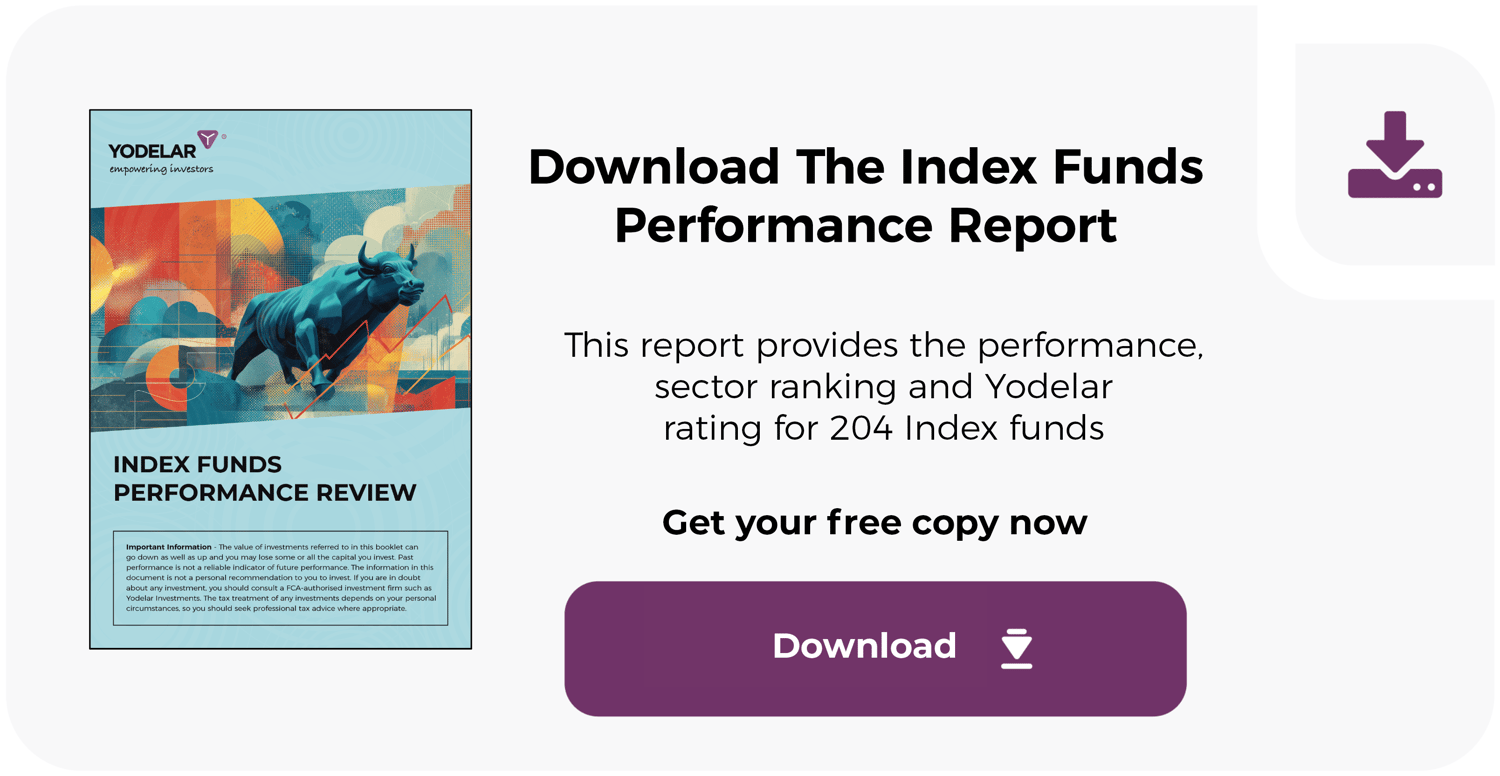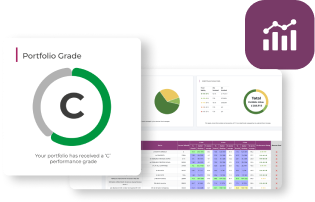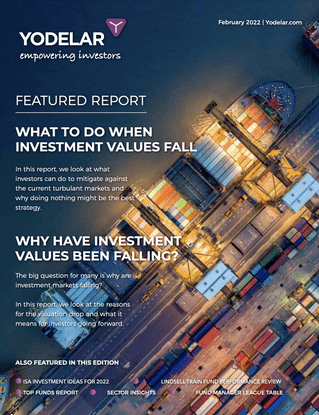-
From an analysis of 204 index-tracking funds, only 9.8% achieved a top 5-Star Yodelar Rating.
-
The L&G Global 100 Index Trust I Acc delivered the highest 5-year return of 123.52%.
-
The Invesco Global ex UK Enhanced Index Fund achieved 5-year growth of 110.81%, outperforming the sector average of 62.22%.
-
The Invesco UK Enhanced Index Fund returned 100.21% over 5 years, outperforming the UK All Companies sector average of 61.77%.
- The top ranked funds within each sector of these 10 index funds were actively managed, highlighting the complementary role of both approaches in diversified portfolios.
Index funds have become a defining feature of modern investing. Built to mirror the performance of market benchmarks, they provide investors with simple, low-cost access to global markets and have proven to be an effective foundation for diversified portfolios. Their transparency and cost efficiency have made them popular across all risk levels — from cautious to growth-focused investors.
Although index investing is designed to be straightforward, results still differ depending on the markets and indices each fund tracks. Global trackers with larger allocations to US equities and major technology companies have led performance in recent years, while regional and balanced strategies have offered steadier, more diversified growth.
To identify which index funds have delivered the strongest results, we analysed 204 index-tracking funds across 1, 3, and 5 year periods to 29 September 2025. This review highlights 10 of the best-performing index funds, and also includes access to the full report which features the performance and ranking of al 204 analysed funds.
Index Fund Performance Summary
For this review, we analysed 204 index-tracking funds and compared their results with all other funds in their respective Investment Association sectors, including both passive and actively managed strategies.
The analysis revealed mixed performance. Only 20 funds (9.8%) achieved a top 5-Star Yodelar Rating, consistently ranking among the best in their sectors over 1, 3, and 5 years. A further 28 funds (13.7%) received 4 Stars, reflecting above-average returns relative to their peers.

In contrast, over 46% of the 204 index funds analysed received a 1- or 2-Star Yodelar Rating, reflecting performance consistently below their sector averages. This illustrates that even within passive investing, outcomes can vary widely depending on the index each fund tracks and how strongly actively managed funds within the same sector have performed over the same periods.
10 Top Performing Index Funds
The 10 funds below are among the best performers from our review of 204 index-tracking funds over the 1, 3, and 5 year periods. Each has delivered competitive results while maintaining low costs and closely tracking its benchmark. Together, they highlight how well-structured index funds can provide consistent, long-term growth across a range of markets and asset types.


HSBC Pacific Index Fund
Sector: IA Asia Pacific ex Japan
OCF: 0.21%
Tracking the FTSE World Asia Pacific excluding Japan Index, this fund provides exposure to large and mid-cap companies across developed and emerging Asia-Pacific markets. It achieved 15.35% over 1 year, 36.21% over 3 years, and 63.13% over 5 years, outperforming its sector averages of 14.26%, 22.54%, and 34.33%. The fund invests in more than 570 companies, with key holdings in Taiwan Semiconductor (18.1%), Samsung Electronics, and major Australian banks. Managed by HSBC Asset Management, its broad diversification across technology and financials has allowed consistent tracking of its benchmark, with minimal tracking error.
Pictet China Index Fund
Sector: IA China/Greater China
OCF: 0.46%
The Pictet China Index Fund replicates the MSCI China Index, providing exposure to over 500 large and mid-cap Chinese equities listed in Hong Kong and the mainland. Over the past year, it recorded a strong rebound of 39.00%, ranking 14th of 65 funds. Its 3-year return of 29.84% significantly exceeded the 11.96% sector average, while the 5-year figure remains negative at -3.43% after prior market volatility. Holdings include Tencent, Alibaba, and BYD, with technology and consumer sectors accounting for more than half of the portfolio. The fund’s full-replication methodology and relatively competitive fee make it a straightforward way to access China’s cyclical recovery.
Vanguard Eurozone Stock Index Fund
Sector: IA Europe Excluding UK
OCF: 0.30%
This fund tracks the MSCI EMU Index, offering exposure to Eurozone large and mid-cap companies such as LVMH, SAP, and Siemens. It achieved 19.96%, 68.19%, and 81.75% over 1, 3, and 5 years, comfortably outperforming sector averages of 11.13%, 18.30%, and 62.29%. The fund’s low OCF and full replication of over 200 holdings ensure precise tracking of European market performance. Vanguard’s disciplined cost control and consistent approach to index management have made this one of the most reliable regional trackers in the market.
L&G International Index Trust Fund
Sector: IA Global
OCF: 0.08%
Tracking the FTSE World ex UK Index, this fund offers diversified exposure to developed and emerging markets outside the UK, including significant allocations to US, European, and Asian equities. With returns of 16.54%, 49.43%, and 89.75% over 1, 3, and 5 years, it outperformed the IA Global sector averages of 11.16%, 35.47%, and 62.22%. Its OCF of 0.08% is among the lowest in the sector, and its straightforward full-replication strategy makes it an efficient core holding for investors seeking global diversification.
Invesco Global ex UK Enhanced Index (UK) Fund
Sector: IA Global
OCF: 0.25%
This fund aims to outperform the MSCI World ex UK Index using a factor-based approach targeting quality, value, and momentum characteristics. Over 1, 3, and 5 years, it achieved 18.67%, 59.02%, and 110.81%, outperforming both its benchmark and the broader global index sector. Its largest exposures include NVIDIA, Apple, and Microsoft, reflecting the fund’s tilt toward high-quality, growth-driven companies. Managed by Georg Elsaesser and Michael Rosentritt, the strategy’s optimised weighting and strict risk controls have helped it consistently deliver index-beating results with minimal additional volatility.
L&G Global 100 Index Trust Fund
Sector: IA Global
OCF: 0.09%
This fund tracks the S&P Global 100 Index, which includes 100 of the world’s largest multinational companies. It achieved 20.81% over 1 year, 63.54% over 3 years, and an exceptional 123.52% over 5 years—among the highest cumulative returns across all index funds reviewed. The portfolio’s concentration in major US technology names such as Microsoft, Apple, and NVIDIA has been the key driver of long-term performance. Despite this growth bias, the fund remains diversified across regions and sectors, offering a cost-effective route to capture global blue-chip equity performance.
Invesco Global Balanced Index (UK) Fund
Sector: IA Mixed Investment 40–85% Shares
OCF: 0.45%
This multi-asset fund combines equity and fixed-income exposure through an optimised, factor-based model that blends quality, value, and momentum styles. It returned 15.84% over 1 year, 27.05% over 3 years, and 79.39% over 5 years, significantly ahead of the sector averages of 9.28%, 2.00%, and 40.81%. The fund tracks a blended benchmark of FTSE All Share, MSCI World ex UK, and UK gilt indices, balancing growth with income generation. Its disciplined structure and strong diversification—spanning over 200 holdings—have enabled it to outperform more expensive active multi-asset strategies.
Invesco UK Enhanced Index (UK) Fund
Sector: IA UK All Companies
OCF: 0.00%
Tracking and aiming to outperform the FTSE All-Share ex Investment Trusts Index, this fund applies a systematic factor model that emphasises companies with strong momentum, value, and quality characteristics. It achieved 17.06%, 54.09%, and 100.21% over 1, 3, and 5 years, beating the sector averages of 8.31%, 17.24%, and 61.77%. The portfolio is broadly diversified across 117 holdings, with large positions in Shell, AstraZeneca, and HSBC. By maintaining a tracking-error target of just 1.5%, it has produced index-like behaviour with consistently higher returns.
iShares 100 UK Equity Index (UK) Fund
Sector: IA UK All Companies
OCF: 0.21%
Replicating the FTSE 100 Index, this fund provides exposure to the UK’s largest blue-chip companies, maintaining a low tracking error through full replication. It achieved 15.49% over 1 year, 47.99% over 3 years, and 92.66% over 5 years—well above the sector averages of 8.31%, 17.24%, and 61.77%. Managed by BlackRock, it holds all FTSE 100 constituents including Shell, AstraZeneca, HSBC, and BP. With an OCF of just 0.21%, it remains a reliable, low-cost core UK equity holding.
abrdn MyFolio Index V Inst Fund
Sector: IA Volatility Managed
OCF: 0.65%
Positioned as the highest-risk profile within the MyFolio Index range, this fund targets 70–110% of global equity volatility using a diversified blend of index trackers. Over 1, 3, and 5 years, it returned 14.91%, 43.17%, and 72.23%, ranking 5th of 201 funds over 1 year and 3rd of 153 over 5 years. Its allocation includes US equities (32%), UK (27%), and Asia Pacific (12%), supported by smaller allocations to fixed income and property. The strategy’s disciplined rebalancing and defined volatility range have helped deliver consistent long-term returns for a multi-asset portfolio.
The Importance of Active Diversification and Ongoing Oversight
Although index funds are designed to track specific benchmarks, their returns still depend on the markets they follow and the way those markets perform over time. Global equity trackers have benefited from the sustained strength of large US and technology companies, while regional funds such as the HSBC Pacific Index and Pictet China Index have captured Asia’s recovery following periods of market volatility.
These variations underline why diversification remains essential. Holding funds across different regions, asset types, and investment styles helps reduce risk and balance returns through changing market cycles.
Professional oversight plays a vital role in maintaining this balance. Through MKC Invest’s discretionary management, portfolios are continually monitored and adjusted to ensure diversification is preserved and each fund continues to contribute appropriately to overall objectives. This disciplined oversight enables investors to retain the low-cost efficiency of index investing while keeping portfolios adaptive and aligned with their goals.
Index vs Active: Understanding the Broader Context
While this analysis focuses on index-tracking funds, it is important to view their results within the broader fund universe. Index funds offer cost efficiency and reliable market-level exposure, but not all deliver superior results compared with actively managed funds in the same sector.
From an assessment of 4,018 Investment Association sector-classified funds, 2,517 were found to consistently underperform their sector averages and received a 1- or 2-star Yodelar Rating. Many of these underperformers were actively managed. However, across the sectors in which the ten top-performing index funds from this report are classified, the very best performers continue to be actively managed funds.
This distinction highlights that the debate between active and passive investing is not a question of which is better, but rather how each can be used effectively. Index funds provide low-cost, transparent access to the market and help anchor portfolio stability, while high-quality active funds have the potential to outperform their benchmarks through selective positioning and tactical decision-making.
In practice, well-constructed portfolios often blend both approaches — using index funds to achieve broad diversification and cost control, while employing active funds to capture additional growth potential in areas where market inefficiencies persist.
Summary
This review of 204 index funds shows that even within passive strategies, performance can vary depending on market exposure and fund structure. Global equity funds have led recent returns, while balanced and regional funds have provided important diversification benefits.
Alongside active strategies, index funds play an essential role in well-constructed portfolios. When used together, they can combine cost efficiency with flexibility and opportunity — creating portfolios that are diversified, risk-managed, and positioned for consistent, long-term outcomes.

















